Abstract
Reintroduction of European bison into the natural environment is one of the most important conservation measures applied for this species. After creating a free herd of European bison, spatial monitoring is crucial. It allows for observation of the population, as well as the detection of potential threats and needs for intervention. In 2016, a new free herd of European bison was introduced to the Żednia District in Knyszyńska Forest. After a few months spent in the acclimation enclosure, the animals were released. The course of their acclimatisation was observed with GPS collars during the next 7 years. Thanks to telemetry monitoring, we could determine the moment when the herd stabilised its home range within available habitats. Monitoring performed for 7 years after the release of the herd confirmed the previously established home range. The fact that the animals remain close to the release site and that there is no damage to the winter crops confirms that the reintroduction site was well chosen.
1. Introduction
The reintroduction of European bison into the natural environment is often controversial [1]. The risk of conflict with people, especially the risk of damage to agricultural crops, raises reasonable concerns [2,3]. Feeding on crops can also be potentially harmful to this species [4]. Moreover, the presence of European bison close to human settlements may be considered dangerous due to the potential risk of attack [5]. There is also potential risk of pathogen transmission between European bison and cattle [6]. Currently, the European bison has the status of “near-threatened” on the IUCN red list; however, it is still close to the status of “vulnerable” due to the population size of the species [7]. Therefore, it is extremely important to continue creating small herds not only in Poland, but also in other European countries [8,9]. The formation of new herds is also important due to the current geopolitical situation, which may result in a decrease in the number of European bison [10]. In addition, the presence of European bison and their activities may have the potential to influence the features and functions of ecosystems. European bison are grazers and may contribute to the maintenance and restoration of open habitats [11]. It is also considered an umbrella species; hence, its presence and protection of the habitat may also support other species [11,12].
There are 2223 European bison in free-range populations in Poland [13]. More than half of the country’s population lives in north-eastern Poland, in the following forest complexes: Białowieska, Knyszynska, Augustowska, Romincka, and Borecka. The populations in the Romincka and Augustowska Forests and the new herd in Knyszynska Forest are the subjects of this study. Knyszynska Forest, located in north-eastern Poland, is one of the largest forest complexes in this country. The forest complex is intersected by agricultural lands, numerous watercourses, and enclaves of meadows and pastures. A free-ranging herd of European bison released over 50 years ago is inhabiting the north-eastern part of Knyszynska Forest (the Waliły and Krynki forest districts) [14,15].
The Żednia Forest District, located to the south of the home range of this population, has not been permanently inhabited by European bison, with only single individuals or small groups of animals appearing there periodically and during migration. The Żednia Forest District, bordering Knyszynska Forest and Białowieska Forest, has been recognised as an important area for connectivity of both European bison populations [15]. The formation of a “bridge” enabling permanent contact between these two populations will expand the range of the European bison from the Białowieska and Knyszynska Forests, as well as the natural migration of individuals between the herds and the exchange of genetic material [15]. The permanent presence of European bison in the Żednia Forest District will increase the biodiversity of this area, as well as improve its attractiveness for tourists. In addition, the formation of a second herd in Knyszynska Forest creates a potential opportunity to disperse the main herd over a larger area, which should have a positive impact on further management of this population.
European bison reintroductions in Poland are based on a system of acclimatisation enclosures [16]. In the winter season, preselected individuals are translocated to an acclimatisation enclosure, with an area of several hectares. Most often, this founding group has animals from two or more different populations. The selection of individuals for the group is a key factor. Usually, the group consists of 6–8 individuals, which include one older cow whose role is to be the leader of the group, one adult bull, and adult cows around 5 years old, as well as juveniles and calves [16]. The appropriate composition of the new herd allows for a quick establishment of the hierarchy and social relations in the group. After being released, they stay together in the enclosure for several weeks. During this period, social relations are established among members of the future free-ranging herd. Thanks to this, the risk of animals separating after release, dispersing in an unknown direction or joining another herd is minimised [17,18]. Activities in Żednia were planned in the same way.
The reintroduction of large herbivores into the environment is always associated with the risk of animals dispersing after their release, which would be a failure of the project [18]. There is also a risk of animals leaving their predefined area, which has been observed in the case of both European and American bison [17,18,19]. On the basis of the example of American bison reintroduced in 2017 in the Banff National Park in Canada, it can be concluded that the use of a number of precautions and limitations for animals can bring satisfactory results and ensure the presence of the herd in their predefined area [20]. Therefore, it is important to conduct spatial monitoring during the first years after reintroduction, which helps in assessing the effectiveness of the applied methods and minimising risks [17,19,20].
The aim of the study was to analyse data concerning the first years of the herd’s life after reintroduction and to try to assess the applied releasing method, which may have an impact on improving the manner of formation of subsequent free-range European bison population.
2. Materials and Methods
2.1. Study Area
The area of European bison reintroduction was located in the southern part of the Knyszynska Forest complex in the region administered by the Żednia Forest District. The “Sokole” meadow complex is traversed by a year-round watercourse and surrounded by forest on all sides. There are no large agricultural crops in the vicinity of this area, and the nearest villages with low-density housing are several kilometres away.
An area of approximately 60 km2 was available for the dispersal of the European bison (Figure 1). However, the area potentially available for European bison in this region is much larger, over 150 km2 of mostly forest area, without extensive development of human settlements. The reintroduction of the European bison herd in the Żednia Forest District was preceded by several years of preparation. A number of tasks were carried out to improve the food base of the species, access to water, and the possibility of feeding animals during the winter. Tens of hectares of mid-forest meadows have been re-established by being mown and returned to agricultural use, while haystacks and feeding racks have been built where hay collected from meadows is spread during the winter.
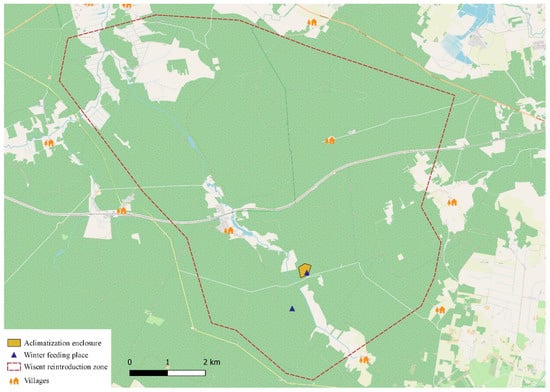
Figure 1.
The area of reintroduction of European bison in the Żednia Forest District in Knyszynska Forest.
For the needs of the project, an acclimatisation enclosure of 4.5 ha was built in the central part of the forest–meadow landscape in a predefined home range of this herd (Figure 1). The enclosure, made of wooden poles, was additionally secured with an electric fence. Within the enclosure, a water reservoir and necessary infrastructure elements including a water pool, feeders, and storing and feeding racks were built.
The chosen location of the new herd release allowed for the minimisation of both the risk of animals leaving and the possible damage to agricultural crops during the winter. The distance of the acclimatisation enclosure from the nearest villages was 2 km to the north (Sokole village) and 2.5 km to the south (Majdan village). The national road, which can be a barrier for European bison, was over 3 km away to the west off the enclosure. From the north, the area of reintroduction was isolated by a road (8 km from the acclimatisation enclosure), which constituted an effective barrier for the European bison while hindering the reintroduced herd from joining the population already functioning in the northern part of Knyszynska Forest.
2.2. Animals
At the end of 2015 and beginning of 2016, eight animals (seven cows aged 1–9 years and a 6 year old bull) were brought to the acclimatisation enclosure from Białowieska Forest. The bull and the oldest cow were equipped with telemetry collars (Ecotone), which facilitated the monitoring of the herd after its release. As expected, the oldest cow took the lead of the group. The animals stayed in the enclosure until the beginning of May 2016. After being released into the wild, the herd was monitored using telemetry and direct observation.
2.3. Data Collection
Data from two collared female European bison (a cow, the group’s leader in 2016–2019, and another adult cow, wearing the transmitter from December 2021) were used for the analysis. The population of European bison in Żednia formed one herd; therefore, the data obtained from a single transmitter represents the behaviour of the entire group. Telemetry collars were equipped with two types of transmitters—VHF and GPS-GSM. The GPS transmitter recorded the location at intervals of 1 h, usually transmitting 24 animal locations per day. The collected data were sent to the server within an interval of 6 h.
After filtering the data and rejecting erroneous measurements, a total of 18,540 locations collected in 2016–2019 and 4322 registered in 2022 were used for further analysis. For the analysis, the year was divided into two seasons: summer (May–October) and winter (November–April). A total of 14,297 locations were registered in the summer, along with 8567 locations in the winter. The analyses of the activity of the European bison herd were carried out in several periods:
- The day of leaving the acclimatisation enclosure;
- The first 3 weeks after release;
- Three subsequent years on a monthly basis and the seventh year after reintroduction, broken down by seasons: summer (May–October) in 2016, 2017, 2018, and 2022 and winter (November–April) at the turn of 2016/2017, 2017/2018, and 2018/2019.
The studies did not include the years 2019–2021 because collar failures prevented the continuity of telemetric monitoring. The analyses were performed in the Quantum Gis 3.22 spatial information system. On the basis of the data, the range of the area was calculated using the minimal convex polygon and kernel 95% methods [21,22]. The value of daily movement was determined as the sum of 24 measurements (interval 1 h), performed on each day of monitoring. The average daily distance was calculated for each season. The greatest distance in a straight line between the herd and the acclimatisation enclosure in each season was also determined. The distances from the acclimatisation enclosure were compared separately for the summer seasons (2016, 2017, 2018, and 2022) and winter seasons (2016/2017, 2017/2018, and 2018/2019). The Kruskal–Wallis test was used, due to the lack of normality distribution of data [23].
3. Results
3.1. First Day after Release
The opening of the enclosure and official release of the European bison took place on 11 May 2016; however, the animals did not leave the enclosure until 2 days later, in the early morning, after which they began active exploration of the available environment (Figure 2). Within 24 h, the European bison covered a distance of 9308 m, which was also the longest daily movement in the 2016 summer season. On that day, they explored an area of 3.11 km2 (MCP) and moved 3299 m away from the enclosure. In the evening, they returned to the area of the acclimatisation enclosure and stayed in the vicinity of the fence (800 m).
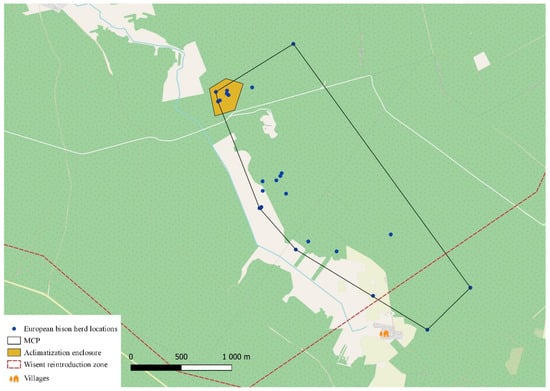
Figure 2.
The activity of the European bison in the first 24 h after leaving the enclosure.
3.2. The First Weeks after Release
During the first weeks, the European bison discovered the available space. Movement towards new areas took place (Figure 3). Area changes occurred every 2–5 days (Table 1).
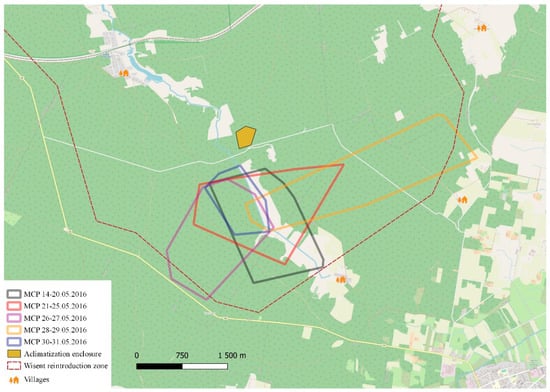
Figure 3.
MCP areas of the European bison in the first weeks after release.

Table 1.
European bison activity in the first weeks after release.
In the first week after release (14–20 May 2016), the European bison explored the forest and meadows on both sides of the watercourse. They moved away from the acclimatisation enclosure for a maximum of 2500 m. The animals covered an average of 4043 m (±671 m) per day. The explored area (MCP) was 2.1 km2.
In the second week (21–25 May 2016), they moved their range to the east and west. They were still in close proximity to the enclosure (2200 m). The penetrated area (MCP) was 2.4 km2, and the average daily movement was 4264 m (±1992 m).
A sudden change of the explored area took place on May 26, when the herd moved in a south-western direction, reaching the road, 3249 m from the acclimatisation enclosure. The herd walked away, without attempting to cross the road, and returned to the “Sokole” meadows, where it remained another day. On 26 May, the movement distance was 8624 m, whereas, on the next day, they covered only 3946 m, moving through the meadows on the western side of the watercourse. During these 2 days, the European bison explored an area of 2.1 km2.
The next visible change occurred on 28 May, when the European bison moved to the east side of the watercourse and began to move east away from the acclimatisation enclosure to a distance of 3860 m, which was the largest distance since the animals were released. The explored area in this 2 day period was 2.9 km2, and the average daily movements were on average 6990 m (±3898.6 m), representing one of the greatest in the entire growing season of 2016.
On 30–31 May, the herd again explored the western side of the watercourse in the “Sokole” meadows, covering an average of 3908 m (±1009.8 m) per day within an area of 0.75 km2.
3.3. Summer Season
Figure 4 and Figure 5 show the areas of MCP and kernel 95% in the analysed summer seasons. In the discussed period, visible changes in the use of the available environment were observed.

Figure 4.
Minimal convex polygon areas during growing seasons.
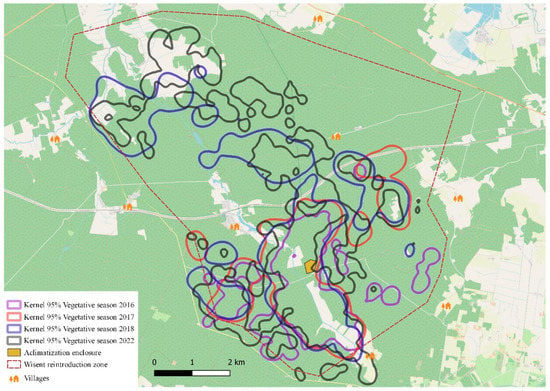
Figure 5.
Kernel 95% areas during growing seasons.
Values illustrating the activity of animals in particular summer seasons are presented in Table 2. Throughout the summer season of 2016, the European bison explored the available environment around the acclimatisation enclosure, moving away from it to a maximum of 3679 m. In the period from the release to the end of October 2016, they explored an area of 25.3 km2. For this period, the area of kernel 95% was 7.8 km2, and the average daily movement was 5182 m.

Table 2.
MCP, kernel 95%, and daily movement values in the monitored summer seasons.
In the following year, the summer area (MCP) increased by 20% in the north-eastern direction, reaching the size of 30 km2. The area of kernel 95% was 10.6 km2, concentrated in a similar area to that in 2016 (Table 2). During the day, the European bison covered an average of 5148 m (SD ± 1991 m). The acclimatisation enclosure was still in the centre of the European bison area. The borders of the European bison area reached 4678 m from the enclosure.
The 2018 summer season brought significant changes. The area of the herd (MCP) increased to 47 km2, and the area of kernel 95% was 16.7 km2 (Table 2). The animals began to explore the area in the northern part of the Żednia Forest District, moving away from the acclimatisation enclosure as far as 7306 m. During the day, the European bison covered an average of 5832 m (SD ± 2875 m).
The following years did not bring any significant changes in the size of the explored areas. It can be assumed that the population established its area in the third year of its presence. For comparison purposes, the summer home range from 2022, which covers the area explored by the herd in 2018 by more than 80%, was taken into account. The total area (MCP) in the 2022 growing season was 51.3 km2, and the area of kernel 95% was 18.4 km2. Daily movements averaged 4219 m (SD ± 1659 m) (Table 2).
In the first year of monitoring, the area of kernel 95% accounted for 30% of the MCP area. In subsequent summer seasons, this ratio increased to 35%, subsequently remaining at this level. The borders of the area were 3.7 km to the east and 7.5 km to the north from the acclimatisation enclosure. To the west and south, the border of the area was marked by a national road running 3–3.6 km away from the acclimatisation enclosure.
The population size slowly grew. No calves were recorded in 2016 and 2017. The first two European bison calves appeared in the herd in the year 2018. In 2019, another two calves appeared, and one death took place; therefore, the population consisted of 11 individuals. The following years brought further development of the herd size, reaching 24 individuals in 2022.
3.4. Winter Season
Figure 6 and Figure 7 present the use of the available environment by the European bison in successive winter seasons. Similarly to the summer seasons, the area of the herd increased.
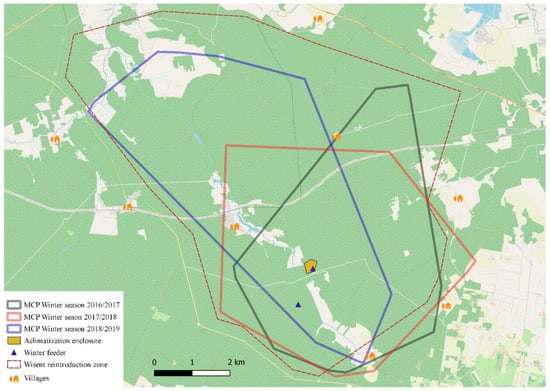
Figure 6.
Minimal convex polygon areas during winter seasons.
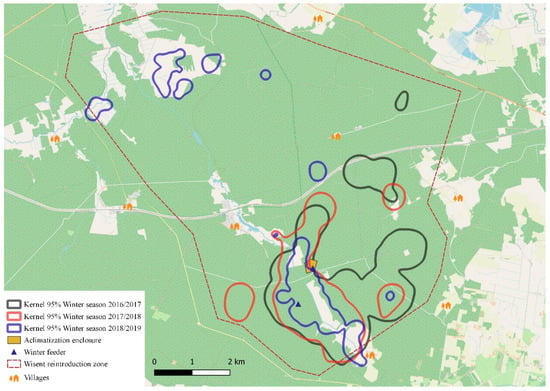
Figure 7.
Kernel 95% areas during winter seasons.
Values illustrating the activity of the European bison in particular winter seasons are presented in Table 3. In the first winter season, the herd moved over an area of 26.2 km2, close to its summer home range. They also explored the forests northeast of the area to a small extent, moving away from the acclimatisation enclosure to a maximum of 5224 m. The area of kernel 95% in this period amounted to 10 km2, focused in the central part of the area, in meadows, and at feeding places (Figure 7). Daily movements were slightly greater than in the summer season, at the level of 5747 m (Table 3).

Table 3.
MCP, kernel 95%, and daily movement values in the monitored winter seasons.
The winter of 2017/2018 did not bring any significant changes. The population foraged over a slightly larger area of 29.7 km2, focusing its activity in the central area (Kernel 95% 6.7 km2) (Table 3).
As in the case of the MCP area, the change took place in the winter of 2018/2019. The population spent most of the winter within the northern borders of its new area, which accounted for 32.6 km2 (MCP). The European bison activity was concentrated in the southern and northern parts of the home range, across an area of only 3.9 km2. This coincided with a much lower level of daily movement, with average of 1723 m (SD ± 1543 m). The border of the winter area was 7 km from the acclimatisation enclosure (Table 3).
The ratio of kernel 95% to MCP in winter decreased year by year. In the first year of observation, the area of kernel 95% accounted for 38% of the MCP area, in contrast to 22% in the second and only 12% in the third.
3.5. The Distance from the Acclimatisation Enclosure
The distance from the enclosure in the summer seasons increased every year, and all seasons were significantly different (p < 0.001, χ2 = 1366.4, df = 3). A noticeable change between the 2017 and 2018 seasons could be observed. A statistically significant decrease in the distance from the enclosure occurred in the 2016/2017 and 2017/2018 (p < 0.001, χ2 = 437.0, df = 2), and then stabilised later on. In the subsequent season of 2018/2019, the distances from the acclimatisation enclosure were smaller than in the first season of 2016/2017, but did not differ from those in the 2017/2018 season (Figure 8).
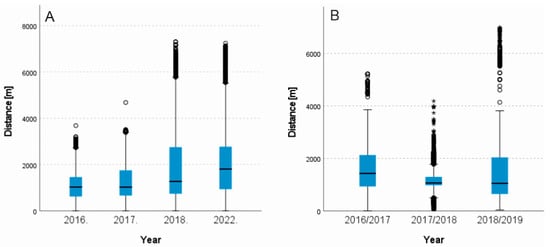
Figure 8.
Distance from acclimatisation enclosure in particular summer seasons (A) and winter seasons (B). Statistically significant differences across all summer seasons, as well as between the winter season 2016/2017 and the other two seasons were observed (◦ represents a single observation, * rep-resents extreme outlier).
4. Discussion
In the first period after the release of the European bison, changes in the occupied area, which occurred every few days, could be explained in several ways. However, they were probably a result of similar exploratory behaviour observed in European bison from different populations. Changes in the area every few days may represent the way European bison learn about a new habitat, as also observed in other reintroduced herds [20,24].
The size of the European bison area is mainly determined by the availability of food [25]. Because of its body size and food requirements, approximately 40 kg of biomass per day, the European bison has high demands concerning the area of its home range [16]. Significant differences in the herd’s home ranges were observed in ecosystems differing in the richness of the food base. Groups of European bison living in mown meadows and mid-forest clearings of Białowieska Forest, which provided an abundant food base, occupied very small areas (approximately 24 km2 on average). Groups living mainly in forest areas penetrated twofold larger territories [25,26,27]. On the other hand, because of the less abundant food base, the European bison population living in the northern part of Knyszynska Forest occupies much larger areas, of over 100 km2 [14,28].
The areas explored by our herd increased year by year. The size of their home range finally stabilised in the third year after release, remaining at a constant level since then. During the next 4 years, the area increased by only 10%, despite a population size that tripled in its 7 years of existence. The seasonal home range of the European bison in this population is similar to the areas occupied by European bison in the Białowieska and Borecka Forests [26,27,28].
During the first 3 weeks after release, the European bison often moved around, and the average distance of daily movements for this period was 4934 m (±1.997 m), which is more than three times longer than the average distance covered per day by European bison in the Bieszczady Mountains and almost twice as long as the average daily movements of European bison in Białowieża Forest [26,29,30]. At the same time, this distance was two times shorter than the daily movements typical for the European bison population inhabiting the northern part of Knyszynska Forest [14]. The observed daily movements of the Żednia herd were similar to those recorded in a herd of the European bison released into the wild in Germany [24].
In the described case, during the first 3 months, the European bison moved approximately 3.6 km away from the enclosure, equating to approximately 1200 m per month. This is a much higher result than that found in the reintroduced herd in Germany [24]. After 3 years of monitoring, the border of the home range, at the farthest point, was situated 7.5 km from the acclimatisation enclosure.
Research on American bison showed a gradual decrease in importance of the acclimatisation area, no longer being used by the animals in later observations [19,20]. The acclimatisation enclosure in Żednia is still located in the central part of the European bison home range, which confirms the proper choice of the location of release site. The uneven expansion of the range of the European bison population in Żednia is probably a result of environmental conditions. As predicted, the herd expanded its area to the north and in the west; however, in the south, the national road 686 represents a significant barrier. In the southeast, there are inhabited villages. Roads and human settlements often constitute a barrier to the movement of wild animals [31,32]. The abundant food base in the summer season and supplementary feeding in the winter season probably prevented the animals from crossing these barriers [33].
To sum up the obtained results, it can be assumed that the reintroduction of European bison to the Żednia Forest District in Knyszynska Forest was a successful project. The availability of the “Sokole” meadows, as well as the surrounding forests rich in food, provided the European bison with all their living needs, regardless of whether they preferred open areas or forests [34,35,36,37]. Almost 7 years after the release of the animals, the area occupied by the herd remained stable despite the growing population. Stable use of the same area and lack of attempts to change it are proof of the perfect selection of conditions for the reintroduction of European bison. This allows hope for future development of the new herd [16,38,39].
Author Contributions
Conceptualisation, M.S., D.K. and W.O.; methodology, M.S. and D.K.; validation, M.S.; formal analysis, M.S. and D.K.; investigation, M.S., D.K. and A.U.-G.; resources, M.S. and D.K.; data curation, M.S.; writing—original draft preparation, M.S. writing—review and editing, M.S., D.K., W.O. and A.U.-G.; visualisation, M.S. and A.U.-G.; supervision, W.O.; project administration, M.S.; funding acquisition, W.O. All authors have read and agreed to the published version of the manuscript.
Funding
This research was funded by the Complex Project of European Bison Conservation by State Forests, which is financed by the Forest Fund (Poland), grant number OR.271.3.10.2017.
Institutional Review Board Statement
Not applicable.
Data Availability Statement
Not applicable.
Acknowledgments
This study would not have been possible without the involvement of employees of the Żednia Forest District directly involved in bison conservation. The authors thank Julia and Katherine Rossi for their kind improvement of the English language.
Conflicts of Interest
The authors declare no conflict of interest.
References
- Klich, D.; Olech, W.; Żygowska, M. The level of knowledge and attitude to European bison from a local perspective—A preliminary study in north-eastern Poland. Ann. Wars. Univ. Life Sci. SGGW Anim. Sci. 2019, 58, 29–36. [Google Scholar] [CrossRef]
- Hofman-Kamińska, E.; Kowalczyk, R. Farm Crops Depredation by European Bison (Bison bonasus) in the Vicinity of Forest Habitats in Northeastern Poland. Environ. Manag. 2012, 50, 530–541. [Google Scholar] [CrossRef] [PubMed]
- Sobczuk, M.; Olech, W. Damage to the crops inflicted by European bison living in the Knyszyn Forest. Eur. Bison Conserv. Newsl. 2016, 9, 39–48. [Google Scholar]
- Klich, D.; Łopucki, R.; Stachniuk, A.; Sporek, M.; Fornal, E.; Wojciechowska, M.; Olech, W. Pesticides and conservation of large ungulates: Health risk to European bison from plant protection products as a result of crop depredation. PLoS ONE 2020, 15, e0228243. [Google Scholar] [CrossRef]
- Haidt, A.; Kamiński, T.; Borowik, T.; Kowalczyk, R. Human and the beast—Flight and aggressive responses of European bison to human disturbance. PLoS ONE 2018, 13, e0200635. [Google Scholar]
- Klich, D.; Didkowska, A.; Pyziel-Serafin, A.; Perlińska-Teresiak, M.; Wołoszyn-Gałęza, A.; Żoch, K.; Olech, W. Ocena ryzyka transmisji chorób między żubrem i bydłem domowym. In Proceedings of the Conference “The return of wisent to Janowskie Forest”, Janów Lubelski, Poland, 8–9 September 2022; pp. 39–40. [Google Scholar]
- Plumb, G.; Kowalczyk, R.; Hernandez-Bianco, J.A. Bison bonasus. The IUCN Red List of Threatened Species. Available online: https://dx.doi.org/10.2305/IUCN.UK.2020-3.RLTS.T2814A45156279.en (accessed on 10 March 2023).
- Olech, W.; Perzanowski, K. European Bison (Bison bonasus) Strategic Species Status Review 2020; IUCN SSC Bison Specialist Group and European Bison Conservation Center, European Bison Friends Society: Warsaw, Poland, 2022; pp. 1–138. [Google Scholar]
- Perzanowski, K. Zarządzanie Populacją Żubra Bison bonasus; Wydawnictwo Łowiec Polski: Warsaw, Poland, 2016; pp. 71–84. (In Polish) [Google Scholar]
- Perzanowski, K.; Klich, D.; Olech, W. European Union needs urgent strategy for the European bison. Conserv. Lett. 2022, 15, e12923. [Google Scholar] [CrossRef]
- Schwerk, A.; Klich, D.; Wójtowicz, E.; Olech, W. Impact of European Bison Grazing (Bison bonasus (L.)) on Species and Functional Traits of Carabid Beetle Assemblages in Selected Habitats in Poland. Biology 2021, 10, 123. [Google Scholar] [CrossRef] [PubMed]
- Olech, W.; Perzanowski, K. Podręcznik Najlepszych Praktyk Ochrony Żubra; Centrum Koordynacji Projektów Środowiskowych: Warszawa, Poland, 2014; pp. 1–98. (In Polish) [Google Scholar]
- Raczyński, J. The European Bison Pedigree Book 2021; Białowieża National Park: Białowieża, Poland, 2022; pp. 1–80. [Google Scholar]
- Sobczuk, M. Analiza Czynników Determinujących Funkcjonowanie Populacji Żubra (Bison bonasus) w Puszczy Knyszyńskiej. Ph.D. Thesis, Szkoła Główna Gospodarstwa Wiejskiego w Warszawie, Warszawa, Poland, 2021. [Google Scholar]
- Perzanowski, K.; Olech, W.; Bozik, K.; Kolenda, B.; Sienkiewicz, M.; Sieradzki, W.P. Strategia Ochrony Żubra w Puszczy Knyszyńskiej na Terenach PGL Lasy Państwowe; Nadleśnictwo Żednia: Żednia, Poland, 2013. (In Polish) [Google Scholar]
- Perzanowski, K.; Bielecki, W.; Olech, W. Nadzór nad Wolnymi Stadami Żubrów. Poradnik; Stowarzyszenie Miłośników Żubrów: Warsaw, Poland, 2013. [Google Scholar]
- Kaliciuk, J.; Wysocki, D.; Bereszyński, A.; Tracz, M.; Tracz, M. Nowe stada żubrów w województwie zachodniopomorskim po roku od utworzenia. Eur. Bison Conserv. Newsl. 2009, 2, 142–147. [Google Scholar]
- Davidson, T.; Norcross, D. Bison Reintroduction in Jasper National Park. Interim Report; Jasper National Park: Jasper, AB, Canada, 1978. [Google Scholar]
- Jung, T.; Larter, N.C. Observations of Long-Distance Post-Release Dispersal by Reintroduced Bison (Bison bison). Can. Field-Nat. 2017, 131, 221–224. [Google Scholar] [CrossRef]
- Zier-Vogel, A.; Heuer, K. The First 3 Years: Movements of Reintroduced Plains Bison (Bison bison bison) in Banff National Park. Diversity 2022, 14, 883. [Google Scholar] [CrossRef]
- Fiberg, J. Kernel density estimators of home range: Smoothing and autocorrelations red herring. Ecology 2007, 88, 1059–1066. [Google Scholar] [CrossRef] [PubMed]
- Reyna-Hurtado, R.; Rojas-Flores, E.; Tanner, G. Home range and habitat preferences of White-Lipped Peccaries (Tayassu pecari) in Calakmul, Campeche, Mexico. J. Mammal. 2009, 90, 1199–1209. [Google Scholar] [CrossRef]
- Kruskal, W.; Wallis, W.A. Use of ranks in one-criterion variance analysis. J. Am. Stat. Assoc. 1952, 47, 583–621. [Google Scholar] [CrossRef]
- Schmitz, P.; Caspers, S.; Warren, P.; Witte, K. First Steps into the Wild—Exploration Behavior of European Bison after the First Reintroduction in Western Europe. PLoS ONE 2015, 10, e0143046. [Google Scholar] [CrossRef]
- Krasińska, M.; Caboń-Raczyńska, K.; Krasiński, Z.A. Strategy of habitat utilisation by European bison in the Białowieża Forest. Acta Theriol. 1987, 32, 147–202. [Google Scholar] [CrossRef]
- Krasińska, M.; Krasiński, Z.A. Żubr. Monografia Przyrodnicza; Chyra.pl: Białowieża, Poland, 2017. [Google Scholar]
- Krasińska, M.; Krasiński, Z.A.; Bunevich, A.N. Factors affecting the variability in home range size and distribution in European bison in the Polish and Belarussian parts of the Bialowieza Forest. Acta Theriol. 2000, 45, 321–334. [Google Scholar] [CrossRef]
- Kowalczyk, R. Żubr—Król Lasów, łąk czy polan i dolin Rzecznych. Ochrona żubra w Puszczy Białowieskiej. Zagrożenia i Perspektywy Rozwoju Populacji; ZS PAN: Białowieża, Poland, 2010. [Google Scholar]
- Caboń-Raczyńska, K.; Krasińska, M.; Krasiński, Z.A.; Wojcik, J.M. Rhythm of daily activity and behavior of European bison in the Białowieza forest in the period without snow cover. Acta Theriol. 1978, 32, 335–372. [Google Scholar] [CrossRef]
- Perzanowski, K.; Januszczak, M.; Wasiak, P. Daily movements of wisents released to the wild in the Bieszczady Mountains. Eur. Bison Conserv. Newsl. 2017, 10, 71–78. [Google Scholar]
- Dean, W.R.J.; Seymour, C.L.; Joseph, G.S.; Foord, S.H. A Review of the Impacts of Roads on Wildlife in Semi-Arid Regions. Diversity 2019, 11, 81. [Google Scholar] [CrossRef]
- Lott, A. Barriers to wildlife movement in straits: Problematizing habitat connectivity across marine ecosystems. Mar. Policy 2022, 141, 105107. [Google Scholar] [CrossRef]
- Kleein, J. Roads and supplemental feeding affect home-range size of Slovenian red deer more than natural factors. J. Mammal. 2012, 93, 1139–1148. [Google Scholar]
- Bereszyński, A. Reintrodukcja żubrów Bison bonasus na Pomorzu Zachodnim. Park. Nar. I Rezerw. Przyr. 2004, 23, 657–665. [Google Scholar]
- Červený, J.; Ježek, M.; Holá, M.; Zikmund, M.; Kušta, T.; Hanzal, V.; Kropil, R. Daily activity rhythm and habitat use of the semi-free European bison herd during the growing season. Lesn. Časopis For. J. 2014, 60, 199–204. [Google Scholar]
- Daleszczyk, K.; Bunevich, A.N. Population viability analysis of European bison populations in Polish and Belarusian parts of Białowieża Forest with and without gene exchange. Biol. Conserv. 2009, 142, 3068–3075. [Google Scholar] [CrossRef]
- Kerley, G.I.H.; Kowalczyk, R.; Cromsigt, J.P.G.M. Conservation implications of the refugee species concept and the European bison: King of the forest or refugee in a marginal habitat? Ecography 2012, 35, 519–529. [Google Scholar] [CrossRef]
- Sobczuk, M.; Ostaszewska, E.; Olech, W. The first year of the new herd of wisents in the Żednia District of the Knyszyńska Forest. Eur. Bison Conserv. Newsl. 2017, 10, 45–52. [Google Scholar]
- Maor-Cohen, M.; Bar-David, S.; Dolev, A.; Berger-Tal, O.; Saltz, D.; Spiegel, O. Settling in: Reintroduced Persian Fallow Deer Adjust the Borders and Habitats of Their Home-Range during the First 5 Years Post Release. Front. Conserv. Sci. 2021, 2, 733703. [Google Scholar] [CrossRef]
Disclaimer/Publisher’s Note: The statements, opinions and data contained in all publications are solely those of the individual author(s) and contributor(s) and not of MDPI and/or the editor(s). MDPI and/or the editor(s) disclaim responsibility for any injury to people or property resulting from any ideas, methods, instructions or products referred to in the content. |
© 2023 by the authors. Licensee MDPI, Basel, Switzerland. This article is an open access article distributed under the terms and conditions of the Creative Commons Attribution (CC BY) license (https://creativecommons.org/licenses/by/4.0/).